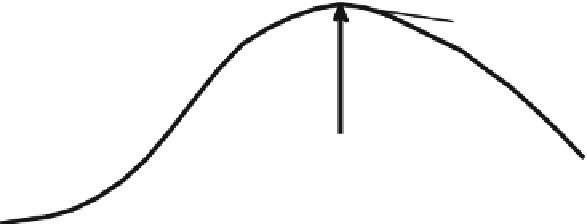Environmental Engineering Reference
In-Depth Information
Power c
o
nversion eff
i
ciency
0.5
Low conversion
efficiency
Low conversi on
efficiency
0.4
0.3
3
0.2
λ
0
opt
0.1
0
-2
-0.1
2
4
6
8
10
12
14
λ
Fig. 7.7
Variation of C
p
with respect to k for b = -2,0,3
Figure
7.7
below shows this relationship for the benchmark wind turbine consid-
ered in this chapter.
From Fig.
7.6
two points must be highlighted:
1. For low wind speeds, to maximise the amount of the captured wind power, the
blade pitch angle b must be held at a fixed angle corresponding to maximum
allowable conversion efficiency curve at which (b = 0). Additionally, the rotor
speed must vary in proportional to the wind speed variation so that k is kept in
the vicinity of it optimal value (k
opt
). Specifically, the generator subsystem
represents the actuator of the aerodynamic subsystem in the low range of wind
speed that decelerates or just releases the aerodynamic subsystem rotation to
adjust the variation of rotor speed, so that good tracking of the optimal rotor
speed ensured. It should be noted that exact tracking of the optimal rotor speed
leads to increasing the load on the drive train shafts and hence minimises the
drive train life time. Moreover, exact tracking will also produce a highly
fluctuating output power and produce a varying direction reference torque
signals that can lead to abnormal generator operation [
26
].
2. For high wind speeds, it is possible to dissipate some proportion of the
available wind power by changing the blade pitch angle to prevent the wind
turbine operation from crossing over the rated power. However, to ensure good
regulation performance, some control strategies use the generator torque con-
trol as a supplementary control signal to overcome the limited rate of change of
blade pitch actuator.
The k
opt
is determined by relating the blade time t
b
and the turbulence time t
w
. t
b
is the time required by the blade to take the position of the previous one and t
w
is
the time required to remove the disturbed wind component generated by the
movement of the blade. See Fig.
7.8
.



















































































